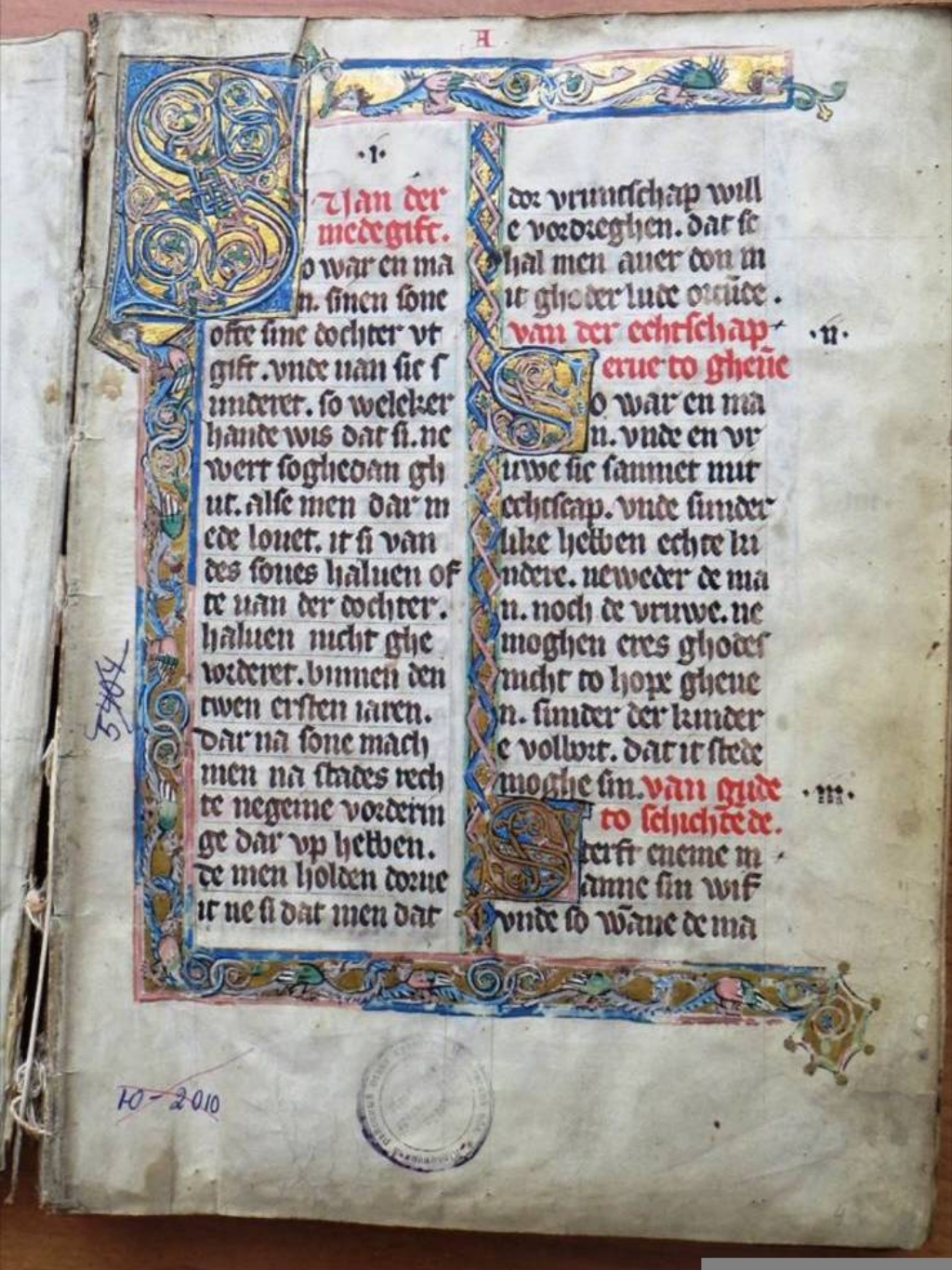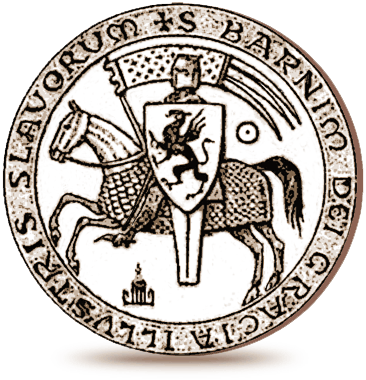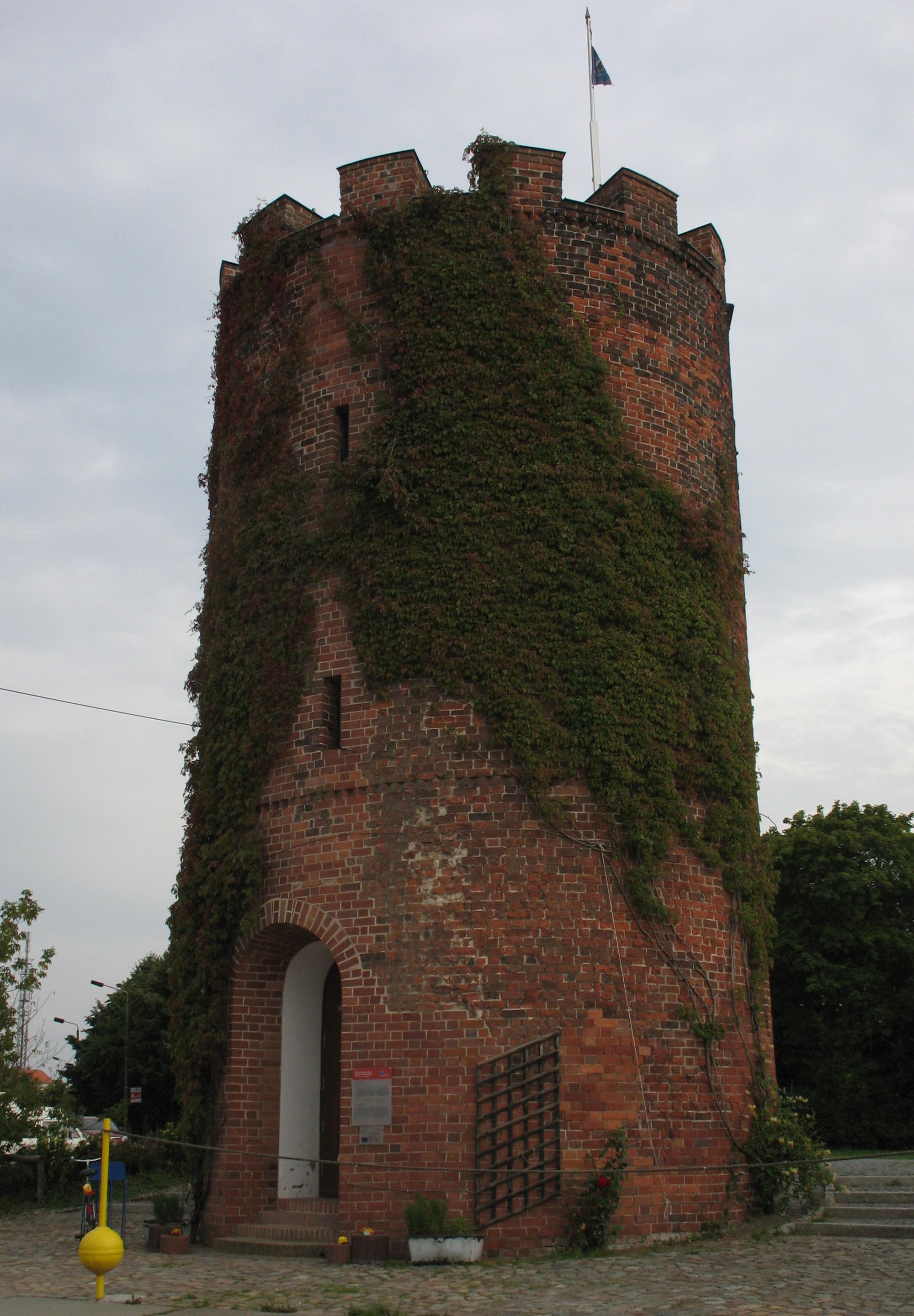|
Wartislaw III, Duke Of Pomerania
Wartislaw III (c. 1210 – 17 May 1264) was a Griffin duke of Pomerania-Demmin. Son of Casimir II of Pomerania-Demmin and Ingardis of Denmark, he was married to a Sophia of an unknown house. As he did not have any children, Pomerania-Demmin ceased to exist with his death. Ingardis ruled Pomerania-Demmin in place of young Wartislaw from Casimir's death 1219 until 1226. At that time, Pomerania-Demmin as well as the other part duchy Pomerania-Stettin were under Danish overlordship, which diminished after the 1227 Battle of Bornhöved and was finally dismissed when Wartislaw successfully countered a Danish expedition in 1234 with his Lübeck allies. 1236 was a harsh year for Pomerania-Demmin, as Wartislaw lost a great part of his possessions to his rivaling neighbors Mecklenburg and the Margraviate of Brandenburg. First, a Mecklenburgian expedition led by Henry Borwin III of Mecklenburg-Rostock annexed most of Circipania, the western part of the duchy comprising the ''terrae'' Gnoi ... [...More Info...] [...Related Items...] OR: [Wikipedia] [Google] [Baidu] |
House Of Pomerania
The House of Griffin or Griffin dynasty (german: Greifen; pl, Gryfici, da, Grif) was a dynasty ruling the Duchy of Pomerania from the 12th century until 1637. The name "Griffins" was used by the dynasty after the 15th century and had been taken from the ducal coat of arms. Duke Wartislaw I, Duke of Pomerania, Wartislaw I (died 1135) was the first historical ruler of the Duchy of Pomerania and the founder of the Griffin dynasty. The most prominent Griffin was Eric of Pomerania, who became king of the Kalmar Union in 1397, thus ruling Denmark, Sweden and Norway. The last Griffin duke of Pomerania was Bogislaw XIV, Duke of Pomerania, Bogislaw XIV, who died during the Thirty Years' War, which led to the division of Pomerania between Brandenburg-Prussia and Sweden. Duchess Anna of Pomerania, Anna von Croy, daughter of Duke Bogislaw XIII, Duke of Pomerania, Bogislaw XIII and the last Griffin, died in 1660. Name of the Dynasty The dynasty is known by two names, ''Pomerania'', after th ... [...More Info...] [...Related Items...] OR: [Wikipedia] [Google] [Baidu] |
Beseritz
Beseritz is a municipality in the Mecklenburgische Seenplatte district, in Mecklenburg-Vorpommern, Germany Germany,, officially the Federal Republic of Germany, is a country in Central Europe. It is the second most populous country in Europe after Russia, and the most populous member state of the European Union. Germany is situated betwe .... References Grand Duchy of Mecklenburg-Strelitz {{MecklenburgischeSeenplatte-geo-stub ... [...More Info...] [...Related Items...] OR: [Wikipedia] [Google] [Baidu] |
Hermann Von Gleichen
Hermann or Herrmann may refer to: * Hermann (name), list of people with this name * Arminius, chieftain of the Germanic Cherusci tribe in the 1st century, known as Hermann in the German language * Éditions Hermann, French publisher * Hermann, Missouri, a town on the Missouri River in the United States ** Hermann AVA, Missouri wine region * The German SC1000 bomb of World War II was nicknamed the "Hermann" by the British, in reference to Hermann Göring * Herrmann Hall, the former Hotel Del Monte, at the Naval Postgraduate School, Monterey, California * Memorial Hermann Healthcare System, a large health system in Southeast Texas * The Herrmann Brain Dominance Instrument (HBDI), a system to measure and describe thinking preferences in people * Hermann station (other), stations of the name * Hermann (crater), a small lunar impact crater in the western Oceanus Procellarum * Hermann Huppen, a Belgian comic book artist * Hermann 19, an American sailboat design built by Ted Herman ... [...More Info...] [...Related Items...] OR: [Wikipedia] [Google] [Baidu] |
Cammin Bishopric
The Bishopric of Cammin (also Kammin, Kamień Pomorski) was both a former Roman Catholic diocese in the Duchy of Pomerania from 1140 to 1544, and a secular territory of the Holy Roman Empire ( Prince-Bishopric) in the Kolberg (Kołobrzeg) area from 1248 to 1650. The diocese comprised the areas controlled by the House of Pomerania in the 12th century, thus differing from the later territory of the Duchy of Pomerania by the exclusion of the Principality of Rügen and inclusion of Circipania, Mecklenburg-Strelitz, and the northern Uckermark and New March. The diocese was rooted in the Conversion of Pomerania by Otto of Bamberg in 1124 and 1128, and was dissolved during the Protestant Reformation, when the Pomeranian nobility adopted Lutheranism in 1534 and the last pre-reformatory bishop died in 1544. The Catholic diocese was succeeded by the Pomeranian Evangelical Church and suppressed until 1945, when its new incarnation, the Apostolic Administration of Kamień (''Cammin''), Lu ... [...More Info...] [...Related Items...] OR: [Wikipedia] [Google] [Baidu] |
Kołobrzeg
Kołobrzeg ( ; csb, Kòlbrzég; german: Kolberg, ), ; csb, Kòlbrzég , is a port city in the West Pomeranian Voivodeship in north-western Poland with about 47,000 inhabitants (). Kołobrzeg is located on the Parsęta River on the south coast of the Baltic Sea (in the middle of the section divided by the Oder River, Oder and Vistula Rivers). It is the capital of Kołobrzeg County. During the Pomerania during the Early Middle Ages, Early Middle Ages, the Pomeranians (Slavic tribe), Pomeranian tribes established a settlement at the site of modern-day Budzistowo. Thietmar of Merseburg first mentioned the site as ''Salsa Cholbergiensis''. Around the year 1000, when the city was part of Poland, it became the seat of the Diocese of Kołobrzeg, one of five oldest Polish dioceses. During the Pomerania during the High Middle Ages, High Middle Ages, the town was expanded with an additional settlement inhabited by German settlers a few kilometers north of the stronghold and chartered with ... [...More Info...] [...Related Items...] OR: [Wikipedia] [Google] [Baidu] |
Lübeck Law
The Lübeck law (german: Lübisches (Stadt)Recht) was the family of codified municipal law developed at Lübeck, which became a free imperial city in 1226 and is located in present day Schleswig-Holstein. It was the second most prevalent form of municipal law in medieval and early modern Germany next to the Magdeburg Law. Lübeck Law provided for municipal self-government and self-administration yet did not negate dependance upon a lord, be it a bishop, duke, king or, in Lübeck's case, an emperor. Instead, it allowed the cities a certain degree of autonomy and self-reliance in legislative, judicial and executive matters. While these authorities were vested in the city council (Rat), the members of which could be elected by co-option, the Lübeck Law represents a significant modernization of governance in that a class of burghers, as opposed to nobles, were responsible for the day to day affairs of governing. The Lübeck Law is not analogous to Hanseatic law. Hanseatic cities ... [...More Info...] [...Related Items...] OR: [Wikipedia] [Google] [Baidu] |
German Town Law
The German town law (german: Deutsches Stadtrecht) or German municipal concerns (''Deutsches Städtewesen'') was a set of early town privileges based on the Magdeburg rights developed by Otto I. The Magdeburg Law became the inspiration for regional town charters not only in Germany, but also in Central and Eastern Europe who modified it during the Middle Ages. The German town law (based on Magdeburg rights) was used in the founding of many German cities, towns, and villages beginning in the 13th century. History As Germans began establishing towns throughout northern Europe as early as the 10th century, they often received town privileges granting them autonomy from local secular or religious rulers. Such privileges often included the right to self-governance, economic autonomy, criminal courts, and militia. Town laws were more or less entirely copied from neighboring towns, such as the Westphalian towns of Soest, Dortmund, Minden, and Münster. As Germans began settling eastwar ... [...More Info...] [...Related Items...] OR: [Wikipedia] [Google] [Baidu] |
Barnim I, Duke Of Pomerania
Barnim I the Good ( – 13 November 1278) from the Griffin dynasty was a Duke of Pomerania (''ducis Slauorum et Cassubie'') from 1220 until his death. Life Son of Duke Bogislaw II and Miroslava of Pomerelia, he succeeded to the Duchy of Pomerania-Stettin upon his father's death in 1220; he had however to share the rule of Pomerania with his cousin Wartislaw III, who resided at Demmin. Because he was minor when his father died, until about 1226 his lands were under the regency of his mother Miroslawa from the Pomerelian Samborides dynasty. At first still a Danish fief, the Pomeranian lands fell back to the Holy Roman Empire after the victory of several North-German princes at the 1227 Battle of Bornhöved. Emperor Frederick II of Hohenstufen in 1231 put the Duchy of Pomerania under the suzerainty of the Ascanian margraves of Brandenburg, disregarding the tenure of the Griffin dynasty, and thereby fueling the long-term Brandenburg–Pomeranian conflict. After his cousin Wartisla ... [...More Info...] [...Related Items...] OR: [Wikipedia] [Google] [Baidu] |
Ostsiedlung
(, literally "East-settling") is the term for the Early Medieval and High Medieval migration-period when ethnic Germans moved into the territories in the eastern part of Francia, East Francia, and the Holy Roman Empire (that Germans had already conquered) and beyond; and the consequences for settlement development and social structures in the areas of immigration. Generally sparsely and only relatively recently populated by Slavic, Baltic and Finnic peoples, the area of colonization, also known as , encompassed (with relation to modern-day countries) Germany east of the Saale and Elbe rivers, the states of Lower Austria and Styria in Austria, the Baltics, Poland, the Czech Republic, Slovakia, Slovenia, Hungary, and Transylvania in Romania. Since the 1980s, historians have interpreted the as a part of a civil and social development, termed the ''High Middle Age Land Consolidation'' ( de , Hochmittelalterlicher Landesausbau). In a pan-European intensification proce ... [...More Info...] [...Related Items...] OR: [Wikipedia] [Google] [Baidu] |
Greifswald
Greifswald (), officially the University and Hanseatic City of Greifswald (german: Universitäts- und Hansestadt Greifswald, Low German: ''Griepswoold'') is the fourth-largest city in the German state of Mecklenburg-Western Pomerania after Rostock, Schwerin and Neubrandenburg. In 2021 it surpassed Stralsund for the first time, and became the largest city in the Pomeranian part of the state. It sits on the River Ryck, at its mouth into the Danish Wiek (''Dänische Wiek''), a sub-bay of the Bay of Greifswald (''Greifswalder Bodden''), which is itself a sub-bay of the Bay of Pomerania (''Pommersche Bucht'') of the Baltic Sea. It is the seat of the district of Western Pomerania-Greifswald, and is located roughly in the middle between the two largest Pomeranian islands of Rugia (''Rügen'') and Usedom. The closest larger cities are Stralsund, Rostock, Szczecin and Schwerin. It lies west of the River Zarow, the historical cultural and linguistic boundary between West (west of the r ... [...More Info...] [...Related Items...] OR: [Wikipedia] [Google] [Baidu] |
Rani (Slavic Tribe)
The Rani or Rujani (german: Ranen, ''Rujanen'') were a West Slavic tribe based on the island of Rugia (Rügen) and the southwestern mainland across the Strelasund in what is today northeastern Germany. The Rani tribe emerged after the Slavic settlement of the region in the ninth century,Ole Harck, Christian Lübke, Zwischen Reric und Bornhöved: Die Beziehungen zwischen den Dänen und ihren slawischen Nachbarn vom 9. Bis ins 13. Jahrhundert: Beiträge einer internationalen Konferenz, Leipzig, 4.-6. Dezember 1997, Franz Steiner Verlag, 2001, p.15, and ranked among the most powerful of several small Slav tribes between the Elbe and lower Vistula rivers before the thirteenth century. They were among the last tribes to hold to Slavic paganism, and the influence of their religious center at Arkona reached far beyond their tribal borders. In 1168, the Rani were defeated by King Valdemar I of Denmark, and his adviser Absalon, Bishop of Roskilde, resulting in the conversion of ... [...More Info...] [...Related Items...] OR: [Wikipedia] [Google] [Baidu] |
Eldena Abbey
Eldena Abbey (german: Kloster Eldena), originally Hilda Abbey (german: Kloster Hilda) is a former Cistercian monastery near the present town of Greifswald in Mecklenburg-Vorpommern, Germany. Only ruins survive, which are well known as a frequent subject of Caspar David Friedrich's paintings, including the famous '' Abtei im Eichwald'' ("Abbey in the Oak Forest"). History Monastery In the 12th century the Baltic coast south of the island of Rügen belonged to the Rani principality of Rügen, which in its turn was subject to the Danes. The Danish Cistercian monastery, Esrum Abbey, was thus able to found a daughter house in the area, Dargun Abbey, at Dargun, west of Demmin, in 1172. When in 1198 this monastery was destroyed in fighting between Denmark and Brandenburg, Jaromar I, Prince of the Rani, whose wife was of the Danish royal house, offered to re-settle the monks at a new site at the mouth of the River Ryck, close to the boundary between the territory of the Princes ... [...More Info...] [...Related Items...] OR: [Wikipedia] [Google] [Baidu] |





